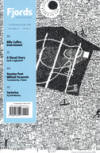Fjords Review – 2013
The experience of a minute occurs differently on a train, in sixty parts, rather than the measurable clattering of east coast winter hellos, vowels in mini-seconds through the incisors. Traveling by rail has been the essential inorganic character of thousands of recollections of the Western canon. Like the prospects of vaudeville and print journalism, it was meant to last forever. And thanks to a moving, technically masterful essay by Barbara Hass in the current issue of Fjords, it does. Her essay, “This Wilderness We Can’t Contain,” is imaginative without losing the tight management of its political and philosophical themes, without unraveling the travel narrative in the irresistible surrealism of the setting. In unpacking the 2011 flood of the Missouri River, she captures an essential rail experience—with the expert and shifting lens of the other elements that contribute to environmental disaster.
The experience of a minute occurs differently on a train, in sixty parts, rather than the measurable clattering of east coast winter hellos, vowels in mini-seconds through the incisors. Traveling by rail has been the essential inorganic character of thousands of recollections of the Western canon. Like the prospects of vaudeville and print journalism, it was meant to last forever. And thanks to a moving, technically masterful essay by Barbara Hass in the current issue of Fjords, it does. Her essay, “This Wilderness We Can’t Contain,” is imaginative without losing the tight management of its political and philosophical themes, without unraveling the travel narrative in the irresistible surrealism of the setting. In unpacking the 2011 flood of the Missouri River, she captures an essential rail experience—with the expert and shifting lens of the other elements that contribute to environmental disaster.
I love her sentences, and her pacing, on a minute level. She manages surrealism rather than letting it overcome her prose: “. . . the train had taken us to a fairy tale place where land wasn’t land and lakes weren’t lakes, an area of magical paradoxes.” Her lyricism is measured. Watching the torrents of rain through the train windows “was like being in a zoo for floods.” Her analysis is concise and elegant. “There’s a lot of down time in nature.” And “Same water, different story . . . Well-behaved rivers had fooled us into thinking we could domesticate water.”
Fjords, a sprint of a journal at less than 100 pages, succeeds in its humor, literary analysis, poetry, and art with a kind of balance you don’t always see in the longer journals, perhaps because with a smaller ship, the crew must be nimbler. For example, there are no contributor notes in the volume. You can find short author biographies on the website, but this collection doesn’t really need them: the voices are clear and the work speaks for itself.
Take Erik Martiny’s “Sartorius,” an essay that turned my generally miserable outlook into unchecked joy. The journal has requested that quotes of this volume be limited to three lines, so I can’t show you how the first three paragraphs of this essay are some of the funniest I’ve ever read—and even a three-line excerpt won’t do the author’s humor justice: “I had what you would call an eccentric childhood . . . my parents were not what you would call Surrealist artists or anything so it wasn’t as if my mother was Leonora Carrington, getting up at night to snip a lock of hair from the sleeping heads of unsuspecting guests . . .” Martiny maintains the quality but segues away from the family and toward a kind of coming-of-age. I hope that this piece develops into a larger work where he can weave together his talent for representing art with his literary acumen.
One of the best features of Fjords is its accessibility. A certain crisis in American poetry might be that the Modernists’ references were too obscure, and those that followed represented a backlash of the obvious. Any extreme in an art movement is going to exclude others, and while it is a privilege to watch trends beget variation on a trend, I think that it is vital for poets of our generation to take the approach that Fjords does, that is, dare to create smart, intellectual work, with enough of a hand-up for those of us who did not major in the Classics.
Take Philip Fried’s “Canticles,” an achingly beautiful poem that can hold its own. Here is the final stanza: “Thou art beautiful, O my love, and terrible as an army / with banners.” Reading the poem in its entirety a few times provides you with a strong affinity for the language. But Fried provides some exposition, and we learn on the opposite page that the language comes from “Song of Songs” and “the terminology of modern warfare,” specifically the Afghanistan war. By providing the reader with some background, the poet invites her to deeply engage with the poem, instead of isolating her and reminding her of her own inability to understand the communication. I think it frees the poet—not just the reader—because the poet can then delve and experiment and not agonize as to whether the work, surely of beauty, is not as incomprehensible as it is lovely. Obscurity was meant for chemistry—carbon and bonds—not songs of love and war.
[www.fjordsreview.com]





